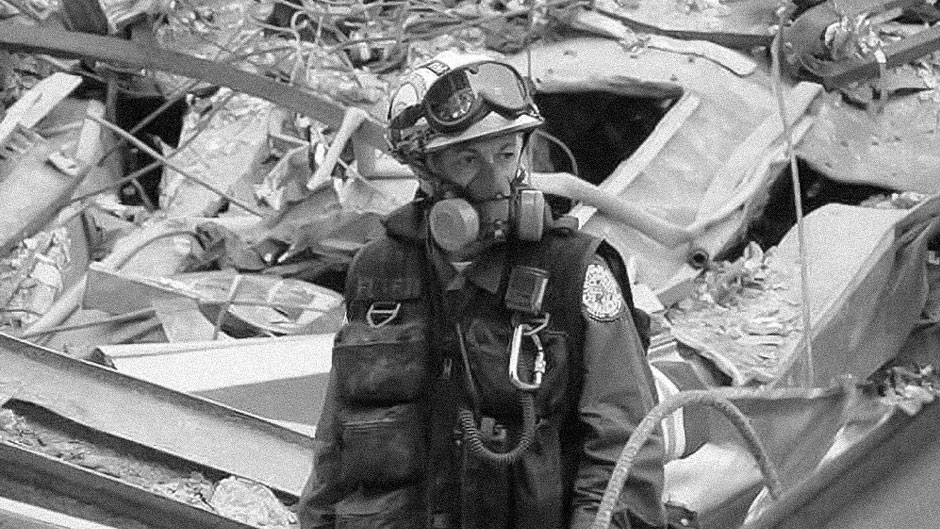It was what the end of the world might look like. Two decades later, G. Patricia Cantwell can still vividly recall the haunting site: the smoldering pile of twisted steel beams and pulverized cement, the crushed automobiles covered in dust.
For seven straight days, the University of Miami Miller School of Medicine physician worked in that nightmare, tending to the medical needs of the elite South Florida Urban Search and Rescue Team/Florida Task Force 2. Composed of City of Miami firefighters and paramedics, the squad had been dispatched to New York City to search for survivors amid the rubble of the collapsed Twin Towers of the World Trade Center.
Now, on the 20th anniversary of the Sept. 11 terrorist attacks, Cantwell is still a member of Florida Task Force 2, having deployed to such disasters as Hurricane Katrina, the 2010 Haiti earthquake, and most recently the partial collapse of the Champlain Towers South condominium in Surfside, Florida.
She has seen training for urban search and rescue deployments evolve immensely since 9/11, and as proof of that, she points to a Federal Emergency Management Agency class that trains first responders how to negotiate a rubble pile and care for crush victims in confined spaces. “We’re always hopeful of finding that void space where someone could survive,” explained Cantwell. “That was the hope at Surfside and at Ground Zero.”
A pediatric critical care physician whose areas of specialty include trauma care, emergency medical services, and disaster medicine, Cantwell also has seen the response to disasters change since the Sept. 11 attacks. “The push has been to build up the experience of state teams to be able to respond quickly,” she said. She noted that Florida Task Force 2 deployed to Mexico Beach immediately after Hurricane Michael devastated the small coastal community on the Florida Panhandle in October 2018. “We had been staged in Ocala, and we were actually driving into the tail end of Michael. So, we were there very quickly and started our search—boots on the ground,” Cantwell said.
Medical training simulation for the armed forces also advanced considerably after the 9/11 attacks, with the University’s Gordon Center for Simulation and Innovation in Medical Education playing an instrumental role. Specifically, the center partnered with the U.S. Army to develop and implement lifesaving training techniques for forward surgical teams (FST) on the battlefield—skills that have been used to train first responders and to treat trauma victims in the civilian world, according to Ivette Motola, director of the Gordon Center’s Division of Prehospital and Emergency Training.
The classes Active Shooter Hostile Events and Emergency Response to Terrorism for First Responders evolved from training the center has offered to Army FSTs, she noted.
What changed more than anything in the realm of post-9/11 training was a new focus on protecting firefighters and paramedics as they respond to manmade and natural disasters, said Barry Issenberg, professor of medicine and the Michael S. Gordon Chair of Medical Education.
“Sept. 11 demonstrated that these individuals put their personal safety aside when answering the call for others,” Issenberg said. “As a result of this, we developed and implemented simulation training that focuses on their personal safety, including simulation scenarios in donning and doffing personal protective equipment in the event of a range of possible events—everything from explosive- and radiologic- to biological- and chemical-related disasters.”
But arguably, one of the biggest post-9/11 responses was the realignment of federal law enforcement agencies that occurred in November 2002, when the U.S. Department of Homeland Security (DHS) began operating with the mission of securing the nation from terrorist threats or attacks, explained Vincent Torres, emergency management director for the University of Miami Health System.
He pointed out that with important information and intelligence not being shared among agencies, critical clues were missed or not passed to the appropriate agency. The realignment allowed for more efficient communication to prevent future attacks.
“Emergency management is constantly evolving, and watershed incidents like 9/11 typically usher in major changes,” said Torres. He added that other initiatives like the Regional Domestic Security Task Force, of which the University’s emergency engagement team is a member, also help multiple agencies to prepare for and respond to terrorist acts.

